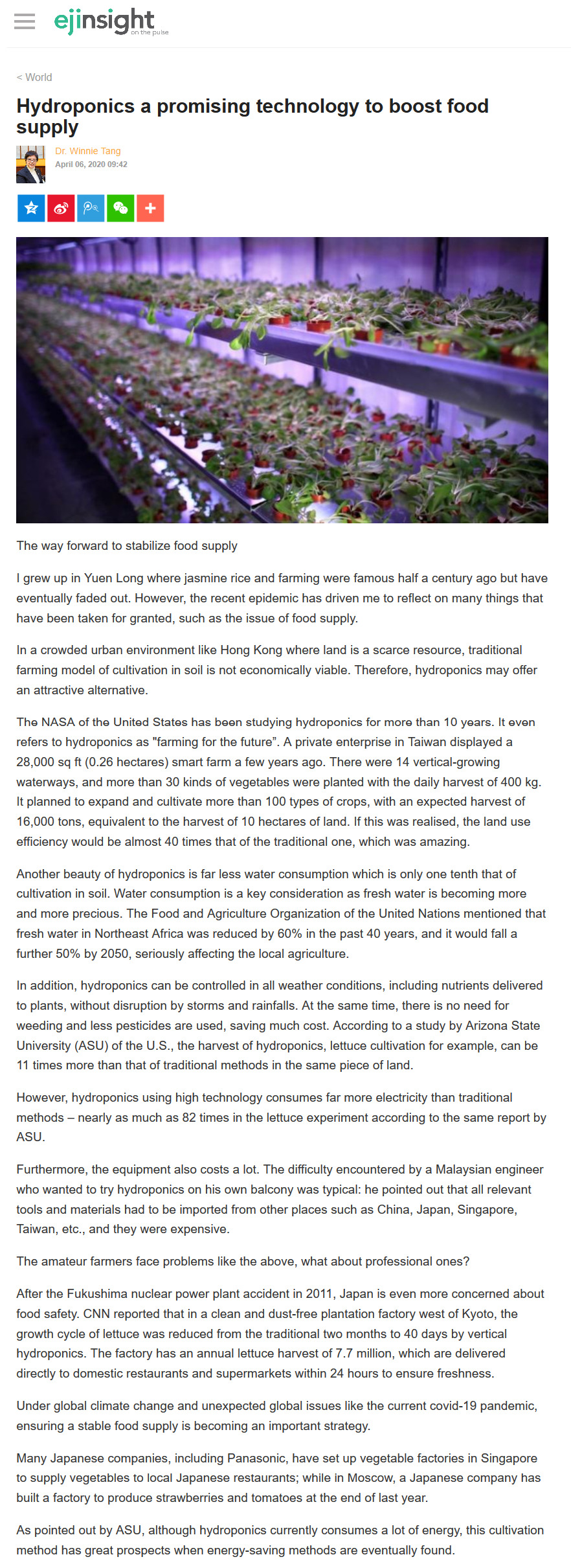網上版請按此

Hydroponics a promising technology to boost food supply
The way forward to stabilize food supply
I grew up in Yuen Long where jasmine rice and farming were famous half a century ago but have eventually faded out. However, the recent epidemic has driven me to reflect on many things that have been taken for granted, such as the issue of food supply.
In a crowded urban environment like Hong Kong where land is a scarce resource, traditional farming model of cultivation in soil is not economically viable. Therefore, hydroponics may offer an attractive alternative.
The NASA of the United States has been studying hydroponics for more than 10 years. It even refers to hydroponics as "farming for the future”. A private enterprise in Taiwan displayed a 28,000 sq ft (0.26 hectares) smart farm a few years ago. There were 14 vertical-growing waterways, and more than 30 kinds of vegetables were planted with the daily harvest of 400 kg. It planned to expand and cultivate more than 100 types of crops, with an expected harvest of 16,000 tons, equivalent to the harvest of 10 hectares of land. If this was realised, the land use efficiency would be almost 40 times that of the traditional one, which was amazing.
Another beauty of hydroponics is far less water consumption which is only one tenth that of cultivation in soil. Water consumption is a key consideration as fresh water is becoming more and more precious. The Food and Agriculture Organization of the United Nations mentioned that fresh water in Northeast Africa was reduced by 60% in the past 40 years, and it would fall a further 50% by 2050, seriously affecting the local agriculture.
In addition, hydroponics can be controlled in all weather conditions, including nutrients delivered to plants, without disruption by storms and rainfalls. At the same time, there is no need for weeding and less pesticides are used, saving much cost. According to a study by Arizona State University (ASU) of the U.S., the harvest of hydroponics, lettuce cultivation for example, can be 11 times more than that of traditional methods in the same piece of land.
However, hydroponics using high technology consumes far more electricity than traditional methods – nearly as much as 82 times in the lettuce experiment according to the same report by ASU.
Furthermore, the equipment also costs a lot. The difficulty encountered by a Malaysian engineer who wanted to try hydroponics on his own balcony was typical: he pointed out that all relevant tools and materials had to be imported from other places such as China, Japan, Singapore, Taiwan, etc., and they were expensive.
The amateur farmers face problems like the above, what about professional ones?
After the Fukushima nuclear power plant accident in 2011, Japan is even more concerned about food safety. CNN reported that in a clean and dust-free plantation factory west of Kyoto, the growth cycle of lettuce was reduced from the traditional two months to 40 days by vertical hydroponics. The factory has an annual lettuce harvest of 7.7 million, which are delivered directly to domestic restaurants and supermarkets within 24 hours to ensure freshness.
Under global climate change and unexpected global issues like the current covid-19 pandemic, ensuring a stable food supply is becoming an important strategy.
Many Japanese companies, including Panasonic, have set up vegetable factories in Singapore to supply vegetables to local Japanese restaurants; while in Moscow, a Japanese company has built a factory to produce strawberries and tomatoes at the end of last year.
As pointed out by ASU, although hydroponics currently consumes a lot of energy, this cultivation method has great prospects when energy-saving methods are eventually found.
Dr. Winnie Tang
Adjunct Professor, Department of Computer Science, Faculty of Engineering and Faculty of Architecture, The University of Hong Kong